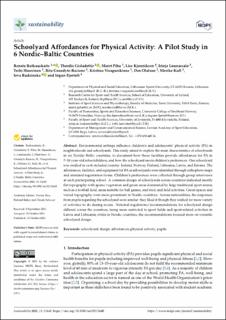| dc.contributor.author | Rutkauskaite, Renata | |
| dc.contributor.author | Gisladottir, Thordis | |
| dc.contributor.author | Maret, Pihu | |
| dc.contributor.author | Kjønniksen, Lise | |
| dc.contributor.author | Lounassalo, Irinja | |
| dc.contributor.author | Huovinen, Teri | |
| dc.contributor.author | Gruodyte-Raciene, Rita | |
| dc.contributor.author | Visagurskiene, Kristina | |
| dc.contributor.author | Olafson, Orn | |
| dc.contributor.author | Kull, Merike | |
| dc.contributor.author | Rudzinska, Leva | |
| dc.contributor.author | Fjørtoft, Ingunn | |
| dc.date.accessioned | 2022-03-16T12:05:36Z | |
| dc.date.available | 2022-03-16T12:05:36Z | |
| dc.date.created | 2022-02-01T10:04:02Z | |
| dc.date.issued | 2021 | |
| dc.identifier.citation | Rutkauskaite, R., Gisladottir, T., Pihu, M., Kjonniksen, L., Lounassalo, I., Huovinen, T., Gruodyte-Raciene, R., Visagurskiene, K., Olafson, O., Kull, M., Rudzinska, I. & Fjørtoft, I. (2021). Schoolyard Affordances for Physical Activity: A Pilot Study in 6 Nordic–Baltic Countries. Sustainability, 13(21), Artikkel 11640. | en_US |
| dc.identifier.issn | 2071-1050 | |
| dc.identifier.uri | https://hdl.handle.net/11250/2985529 | |
| dc.description.abstract | Environmental settings influence children’s and adolescents’ physical activity (PA) in neighborhoods and schoolyards. This study aimed to explore the main characteristics of schoolyards in six Nordic–Baltic countries, to document how those facilities provide affordances for PA in 7–18 year–old schoolchildren, and how the schoolyard meets children’s preferences. One schoolyard was studied in each included country: Iceland, Norway, Finland, Lithuania, Latvia, and Estonia. The affordances, facilities, and equipment for PA in schoolyards were identified through orthophoto maps and standard registration forms. Children’s preferences were collected through group interviews at each participating school. A common design of schoolyards across countries indicated mostly flat topography with sparse vegetation and green areas dominated by large traditional sport arenas such as a football field, areas suitable for ball games, and track and field activities. Green spaces and varied topography were more prominent in Nordic countries. Across nationalities, the responses from pupils regarding the schoolyard were similar: they liked it though they wished for more variety of activities to do during recess. National regulations/recommendations for schoolyard design differed across the countries, being more restricted to sport fields and sport-related activities in Latvia and Lithuania, while in Nordic countries, the recommendations focused more on versatile schoolyard design. | en_US |
| dc.language.iso | eng | en_US |
| dc.rights | Navngivelse 4.0 Internasjonal | * |
| dc.rights.uri | http://creativecommons.org/licenses/by/4.0/deed.no | * |
| dc.title | Schoolyard Affordances for Physical Activity: A Pilot Study in 6 Nordic–Baltic Countries | en_US |
| dc.type | Peer reviewed | en_US |
| dc.type | Journal article | en_US |
| dc.description.version | publishedVersion | en_US |
| dc.rights.holder | © 2021 by the authors. | en_US |
| dc.source.pagenumber | 11640 | en_US |
| dc.source.volume | 13 | en_US |
| dc.source.journal | Sustainability | en_US |
| dc.source.issue | 21 | en_US |
| dc.identifier.doi | https://doi.org/10.3390/su132111640 | |
| dc.identifier.cristin | 1996075 | |
| cristin.ispublished | true | |
| cristin.fulltext | original | |
| cristin.qualitycode | 1 | |

